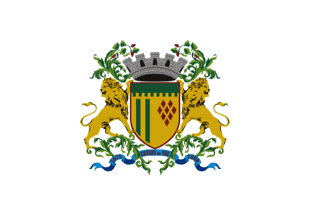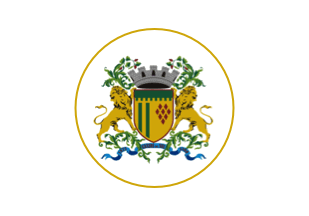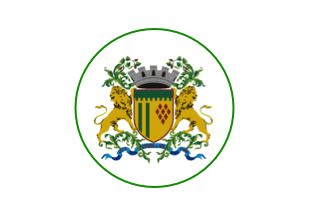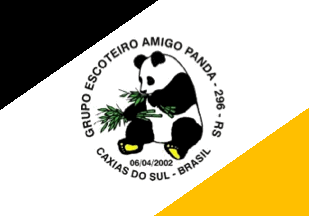 image by Ivan Sache,
13 July 2020
image by Ivan Sache,
13 July 2020
Last modified: 2020-07-14 by ian macdonald
Keywords: rio grande do sul | caxias do sul |
Links: FOTW homepage |
search |
disclaimer and copyright |
write us |
mirrors
 image by Ivan Sache,
13 July 2020
image by Ivan Sache,
13 July 2020
The municipality of Caxias do Sul (483,377 inhabitants in 2017, therefore the
2nd most populated municipality in Rio Grande do Sul) is located 130 km of Porto
Alegre.
Caxias do Sul originates in the establishment of a colony in the
1870s. Covering four square leagues, the colony was divided in rural and urban
plots. The plots were separated by "linhas" (lines), paths of 7 to 13 km in
length, open in the forest. Rural plots had a nominal area of 22 to 25 ha, but
were sometimes bigger in practice, up to 80 ha.
In 1875, Caxias was known as
Fundos de Nova Palmira, due to its location south of the German colony of Nova
Palmira. Massive Italian immigration caused the colony to be renamed to Nova
Milano - a name still used by the 2nd district of Farroupilha - and Barracão -
"barracks", for the provisory building erected to house the newcomers.
On 11
April 1877, the colony was renamed to Colônia Caixas by the Special Inspector of
Lands and Colonization of the Province of Rio Grande; the colony's seat was set
up in the 5th league, now Caixas downtown. The colony remained locally known as
Campo dos Bugres (Buggers' Field) as a reference to the Caingangue who once
lived in the area. The colony was divided in three seats in 1880: Caxias, Nova
Milano and Nova Trento; the settlement housing the Directorate of the Colony and
the Commission of Lands and Colonization was renamed to Sede Dante. in 1883, the
colony counted 7,359 inhabitants (vs 3,849 in 1878) and 93 commercial
establishments (vs only 3 in 1878).
Côlonia Caxias was elevated to the
5th district of São Sebastião do Caí on 12 April 1884, as Freguesia de Santa
Tereza de Caxias. The municipality of Santa Tereza de Caxias was established on
20 June 1890, composed of three districts: Santa Tereza de Caxias (seat), Nova
Trento and Nova Milano.
Santa Tereza de Caxias was soon connected to the rest
of the word by telegraph (1895), phone (1906), and railway (1910). The town was
granted the rank of "cidade" by Decree No. 1,607 issued on 1 June 1910, under
the simplified name of Caxias. The name Caxias do Sul was prescribed by Decree
No. 720 issued on 29 December 1944.
https://caxias.rs.gov.br/
Municipal website
Caxias' namesake is the Duke of Caxias, Protector of the Brazilian Army.
Luiz Alves de Lima e Silva (1803-1880) was the son of Field Marshal Francisco de
Lima e Silva, a favorite of Empress Leopoldina. Little is known about his youth
before admission to the Royal Military Academy in 1818. Promoted to the rank of
Lieutenant in 1821, he was incorporated to the 1st Fusilier Battalion.
After
the proclamation of the independence of Brazil, Peter I organized in October
1822 in the Santana Camp the Imperial Honor Guard and the Emperor's Battalion,
the latter being composed of 800 elite soldiers. Luiz Alves received in the
Imperial chapel on 10 November 1822 the flag of the Empire, granted by the
emperor himself. He soon experienced his baptism by fire when the battalion was
sent to Bahia on 3 June 1823 to suppress the anti-independence uprising raised
by General Madeiro de Melo. He was rewarded with the title he cherished the most
all his life long, Independence Veteran.
As a captain, he gallantly fought
with the Emperor's Battalion in 1825 during the Cisplatine War, being rewarded
with the rank of Major.
The Balaiada revolt, which broke out in 1838 in
Vila da Manga (Maranhão), was named for one of its leaders, the "balaio" (basket
wicker) Manoel Francisco dos Anjos Ferreira. Joined by 3,000 runaway slaves led
by Cosme Bento, the rebels captured the town of Caxias in 1839, with the support
of the local Liberal elite, which was in struggle with the Conservative
provincial government.
The regency government commissioned Lieutenant-Colonel
Luís Alves, appointed President of Maranhão, to suppress the rebellion.
Commanding a troop of 8,000 soldiers, he defeated several times the rebels, who
were offered amnesty and eventually surrendered in January 1841.
As a reward,
Luís Alves was created Baron of Caxias on 18 July 1841. The same year, he was
unanimously elected Representative of the Province of Maranhão at the
Legislative Assembly and promoted to the rank of Brigadier; the next year, he
was appointed Commander of the Court's Army. After the uprising held in May 1842
by the Liberal Party in São Paulo, Caxias was named Commander-in-Chief of the
forces sent to suppress the revolt and Vice-President of the province of São
Paulo. He succeeded within slightly more than one month and was sent to Mato
Grosso, "pacifying" the province in September 1842. As a reward he was promoted
to the rank of Field Marshal on 30 July 1842 and soon appointed
Commander-in-Chief of the troops and President of the Province of Rio Grande do
Sul, where more than ten presidents and generals had failed to stop the
Ragamuffin revolt. Caxias obtained the end of the rebellion by the peace treaty
signed in Ponche Verde on 1 March 1845. Accordingly, he was proclaimed Peace's
Councillor and Pacifier of Brazil, and created Count of Caxias.
Caxias
went back to Rio Grande do Sul in 1851 as President of the province and
Commander-in-Chief of the Southern Army; on 5 September 1851, he entered Uruguay
and defeated Manuel Oribe, decreasing the pressure on the southern border of
Brazil. Promoted to the rank of Lieutenant-General in 1853, he was created
Marquis of Caxias the same year.
The Triple Alliance War broke out in 1865,
opposing Brazil, Argentina and Uruguay to Paraguay. Caxias, promoted to the rank
of Army Marshal, was appointed the next year Commander-in-Chief of the Imperial
Forces. For the first time in America, he used an aerostat to watch a battle
field. Among his achievements are the building of the Grand Chaco road, which
allowed the Brazilian forces to invade Paraguayan Chaco, the fight for the
bridge over river Itororó ("Brazilians, follow me!"), and the eventual seizure
of Asunción, the capital of Paraguay, on 1 January 1869. As a reward, he was
created Duke of Caxias the same year.
Most historians consider Caxias as
the greatest Brazilian military officer ever. His birthday (25 August) was made
on 25 August 1932 the Day of Soldier; he was proclaimed Protector of the Army on
13 March 1962.
http://www.eb.mil.br/patronos/-/asset_publisher/DJfoSfZcKPxu/content/biografia-resumida-do-duque-de-caxias
Biography, Army official website
Ivan Sache, 13 July 2020
The flag and arms of Caxias do Sul are prescribed by Municipal Law No. 2,170
promulgated on 24 April 1974.
Article 1.
1) Coat of arms.
The coat
of arms shall be composed of a field or (representing wheat crops, a culture
originating in the region), outlined purpure; a narrow chief embattled vert
(representing the municipality's industry); two pallets vert in pale dexter
beneath the chief (representing the Brazilian pines natives from the region) and
eight rhombs 2, 3, 2 and 1 purpure sinister beneath the chief (representing
vineyards). The shield surmounted by a mural crown argent with eight towers,
five visible. The shield surrounded by acanthus leaves and grapevine fructed
proper; the whole guarded by two lions proper, one dexter looking at dexter, the
other sinister looking at sinister the two applying the forepaws to the shield
and the rear paws to the acanthus leaves, as the symbol of the coat of arms of
the Province of Venezia. Beneath the shield a scroll blue interlaced with the
acanthus leaves proper supporting the lions and inscribed purpure "Caxias do
Sul" in the center, "1875" dexter and "1880" sinister (which are the dates of
initiation of Italian colonization in the region and of municipal emancipation,
respectively).
2) Flag
The flag shall be plain white, charged in the
center with the municipal coat of arms.
4) Colors
The municipal
colors, as shown on the coat of arms, shall be green (representing Brazilian
pines and forest), yellow (representing wheat), and purple (representing
grapes).
https://leismunicipais.com.br/a/rs/c/caxias-do-sul/lei-ordinaria/1974/217/2170/lei-ordinaria-n-2170-1974-estabelece-os-simbolos-oficiais-de-caxias-do-sul-representados-pelas-armas-bandeira-selo-e-cores-municipais?q=bandeira
Leis Municipais database
Photos
https://www.facebook.com/prefeituradecaxias/
https://www.facebook.com/prefeituradecaxias/
http://pioneiro.clicrbs.com.br/rs/geral/noticia/2017/08/chegada-do-fogo-simbolico-marca-inicio-das-comemoracoes-em-caxias-9878398.html
On flags used indoors, the coat of arms is inscribed in a circle, either
yellow or green:
 image by Ivan Sache,
13 July 2020
image by Ivan Sache,
13 July 2020
Photos - yellow circle
https://agoranors.com/2019/12/prefeito-caxias-afastado/
https://gcpstorage.caxias.rs.gov.br/images/2019/05/00c074c3-983b-401e-97fb-e6d152eae0f3_1200.jpg
https://www.prb10.org.br/noticias/municipios/prefeitura-de-caxias-do-sul-autoriza-compra-de-medicamentos-para-distribuicao-nas-ubss/
 image by Ivan Sache,
13 July 2020
image by Ivan Sache,
13 July 2020
Photos - green circle
https://www.correiodopovo.com.br/not%C3%ADcias/cidades/flávio-cassina-é-eleito-prefeito-de-caxias-do-sul-1.391998
http://pioneiro.clicrbs.com.br/rs/politica/noticia/2017/12/camara-analisa-nesta-terca-feira-acolhimento-do-pedido-de-impeachment-do-prefeito-daniel-guerra-10059726.html
https://www.spacofm.com.br/politica-novo-comando--flavio-cassina-e-eleito-novo-prefeito-de-caxias-do-sul--;noticia19644.html
https://www.facebook.com/prefeituradecaxias
https://www.facebook.com/prefeituradecaxias
https://www.facebook.com/prefeituradecaxias
Ivan Sache, 13 July 2020
 image by Ivan Sache,
13 July 2020
image by Ivan Sache,
13 July 2020
The flag of Grupo Escoteiro Amigo Panda (Scout Group No. 296/RS, 16th
District) is white with a black triangle in upper hoist and an orange triangle
in lower fly. The group's emblem, featuring a great panda, is placed in the
flag's center.
Photos
https://www.facebook.com/prefeituradecaxias/photos/a.2539627906260314/2539636519592786/?type=3&theater
https://www.bitcomtv.com.br/web/noticia/6086/grupo-de-escoteiros-de-caxias-do-sul-monta-acampamento-modelo-no-shopping-san-pelegrino/
Ivan Sache,
13 July 2020